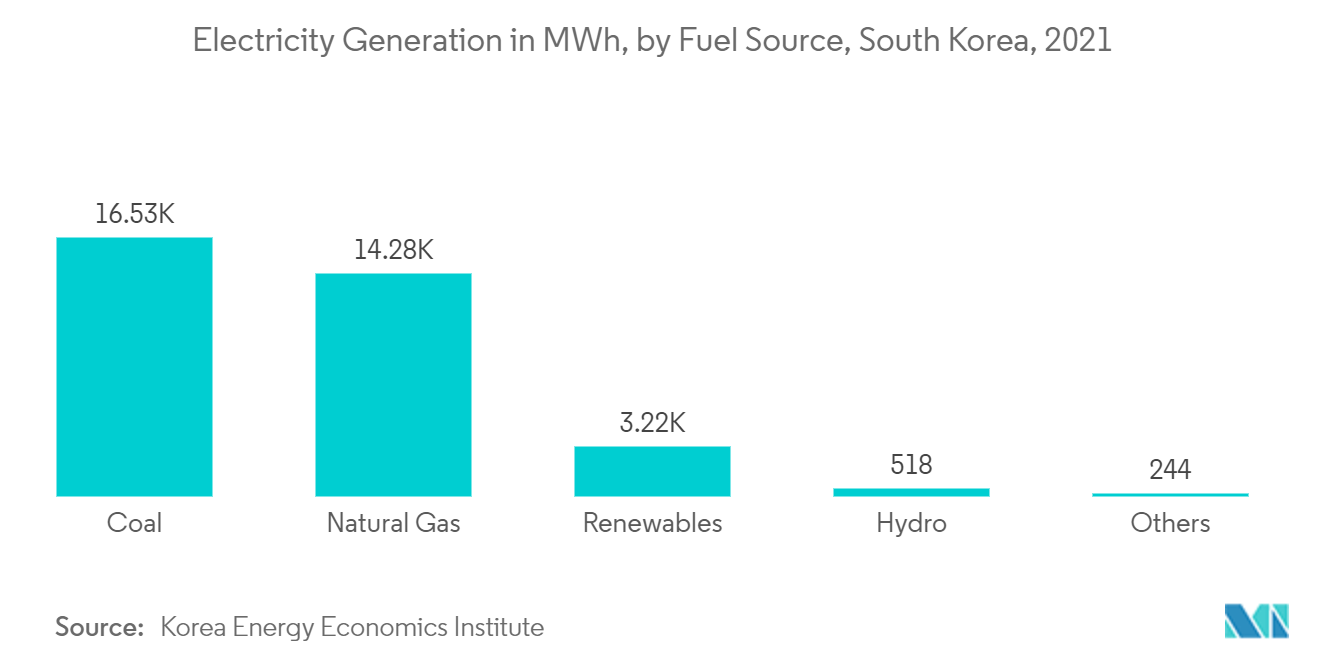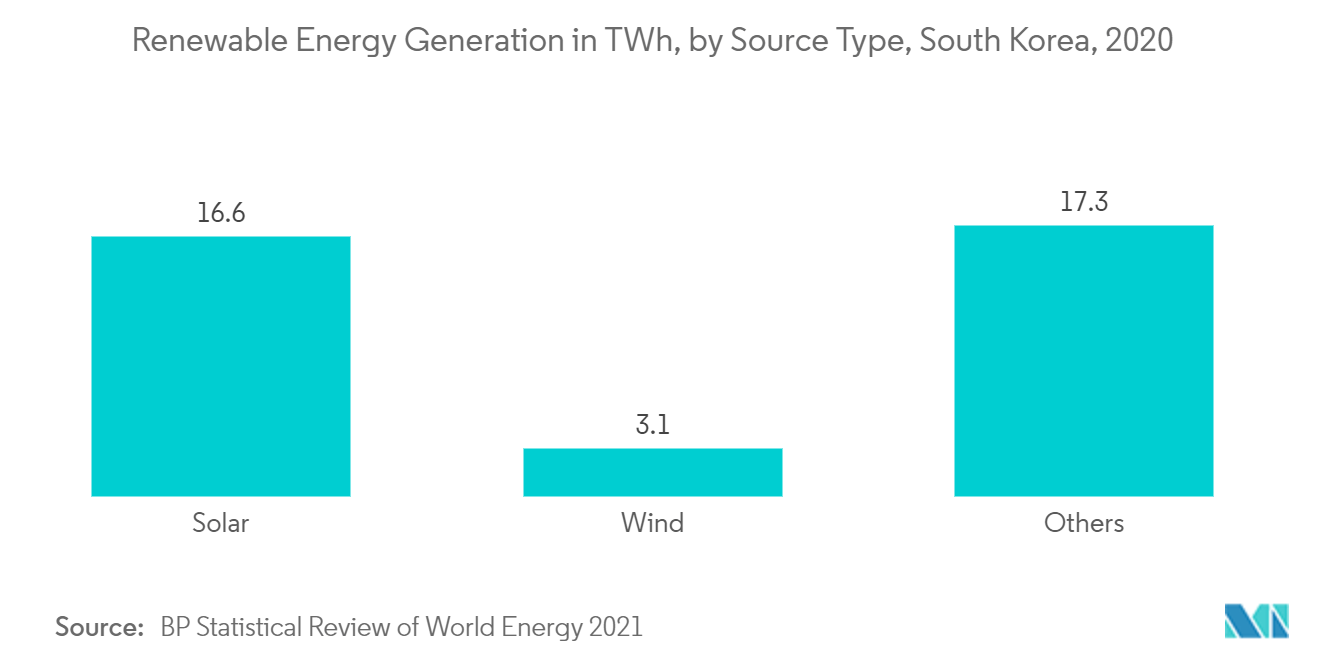Market Trends of South Korea Combined Heat and Power Industry
This section covers the major market trends shaping the South Korea Combined Heat & Power Market according to our research experts:
Natural Gas Segment to Witness Significant Demand
- Traditionally, natural gas has accounted for most of the fuel for the combined heat and power (CHP) industry. Natural gas has been the long runner in the CHP sector for years and has made a name for its efficiency, environmental compatibility, and safety.
- South Korea is among the other countries that depend primarily on fossil fuels for electricity generation. According to the Korean Energy Economic Institute, in 2021, coal accounted for almost 35% of the electricity generation, nuclear (31%), gas (27%), renewables (6%), and the remaining others.
- In October 2020, South Korea announced its pledge to achieve net-zero emissions by 2050. The country was a significant emitter at 586 million tons of CO-equivalent in 2019 (2% of global annual emissions). Korea's power and industrial sectors are the significant contributors to annual national emissions at 37% and 36%, respectively. Thus, the country is further expected to increase the use of natural gas as a fuel in CHP in the coming years.
- The natural gas-based CHP in South Korea has witnessed considerable development over several years, especially from the large-scale segment. In October 2021, SK Chemicals, a leading chemical company in South Korea, announced that it had decided to make a full-scale commitment to its Eco-friendly LNG-powered CHP Plant Business. The company's multi-utility business is to convert 100% of the fuel used at the obsolete combined heat and power facility to LNG following the government's Nationally Determined Contribution (NDC) and the policy to expand the distribution of decentralized energy. Such scenarios are expected to convert fuels from coal to LNG among the CHP businesses in industrial complexes in South Korea, improving reducing greenhouse gas emissions and boosting the natural gas-based CHP market during the forecast period.
- Furthermore, in February 2022, GE announced that it had started the commercial operation of GS Power's Anyang CHP Plant Unit 2-2 in Anyang City, South Korea. The project consists of the renewal of older gas-powered assets with the latest turbine technology and a distributed control system (DCS) software solution to support the availability and reliability of the plant. The updated CHP plant now delivers about 500 megawatts (MW) of electricity to approximately 500,000 South Korean homes and provides steam for district heating for more than 180,000 citizens of Anyang City.
- Gas-based power plants play an essential role in facilitating South Korea's transition to a more energy-efficient, reliable, and lower carbon future. Since the country's long-term goal is to increase its reliance on renewable power sources, gas-based power generation is crucial to ensure the needed power to balance the variable nature of renewables and ensure system reliability in the future.
- Therefore, based on the points mentioned above, the natural gas-based fuel type segment is anticipated to witness significant demand in South Korea during the forecast period.

Increasing Adoption of Renewable Technologies and Ambitious Targets Restraining the Market Growth
- In 2020, wind and solar energy sources generated just around 3.8% of South Korea's electricity, up from 1% in 2015. In 2021, renewable power saw a considerable rise accounting for about 6% of South Korea's energy mix, which was still the lowest among all OECD members. However, the government plans to increase the share of renewable electricity to 20% by 2030 and 42% by 2034. This is expected to witness significant development in the renewable sector, thus, hampering the CHP market growth in the coming years.
- The country has witnessed a massive adoption of renewable energy sources such as solar, especially in the past couple of years. To meet the 2030 renewables target, Korea is developing large-scale solar power projects. For instance, in 2021, the Korean New and Renewable Energy Center (KNERC), a division of the Korea Energy Agency, announced that it had allocated 2.05 GW of solar capacity in its latest auction. In this auction, the agency selected 7,663 solar projects with an average tariff of KRW 136.129 (~USD0.118)/kWh. Such solar projects are likely to see massive developments in the country.
- Furthermore, in March 2022, South Korea opened one of the world's most significant floating solar projects with 92,000 flower-shaped solar panels installed in a 20 km long reservoir in the southern city of Hapcheon. According to Hanwha Solutions Corp., the plum blossom-shaped solar panels can generate 41 MW, enough energy to power 20,000 homes.
- Moreover, the country's capital, Seoul, was installing solar panels on all public buildings and 1 million homes. The project, dubbed "Solar City Seoul," is a part of a broader national program to wean the country off its dependence on non-renewable energy sources like coal, gas, and nuclear power. Such initiatives are expected to limit the use of CHPs, especially among the residential and commercial end-users.
- South Korea plans to build an 8.2GW offshore wind facility by 2030, with an investment of USD 43.2 billion (KRW48.5 trillion). This development is expected to become the world's most significant single offshore development when completed.
- Therefore, the increasing adoption of renewables in power generation and the ambitious targets set by the government are expected to slow down the pace of the CHP market in South Korea during the forecast period.


